Business Strategy: Article Review Report for BUS300 Module
VerifiedAdded on 2020/05/28
|9
|2939
|46
Report
AI Summary
This report presents a comprehensive review of several articles focused on business strategy. The articles delve into critical aspects such as the application of Porter's generic strategies and the importance of contingency planning. It examines the challenges in strategy formulation and implementation, emphasizing the role of leadership, culture, and alignment within organizations. The review also explores the relationship between organizational culture and strategy, particularly within the South African context, and addresses the application of strategic management within the hospitality industry. The analysis highlights key concepts, including the alignment of strategy, culture, and leadership, and the importance of adapting strategies to changing market conditions and internal organizational capabilities. The report also emphasizes the significance of strategic thinking, and the impact of organizational culture on the success of strategy implementation. This report is a valuable resource for students seeking to understand the complexities of business strategy, with insights from various perspectives.
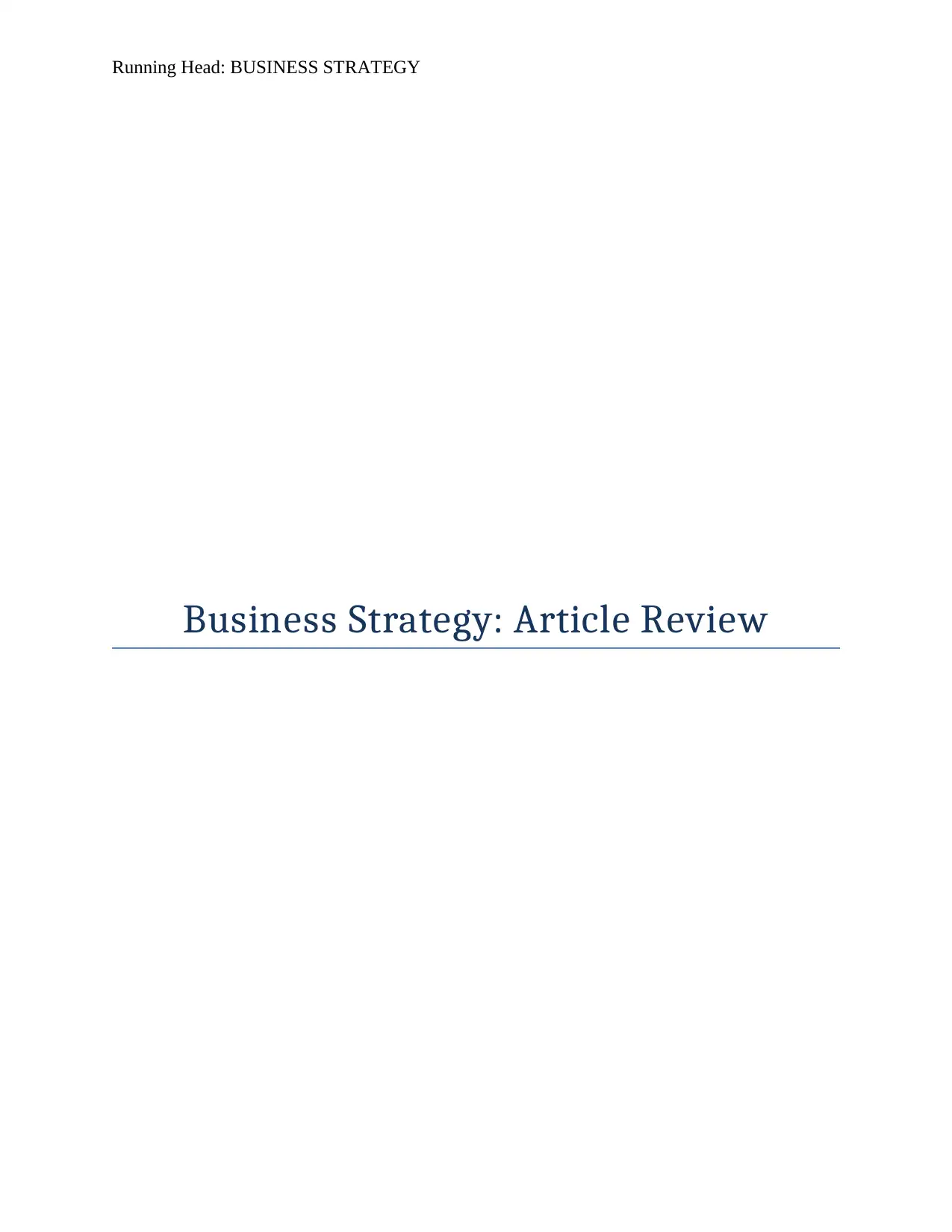
Running Head: BUSINESS STRATEGY
Business Strategy: Article Review
Business Strategy: Article Review
Paraphrase This Document
Need a fresh take? Get an instant paraphrase of this document with our AI Paraphraser
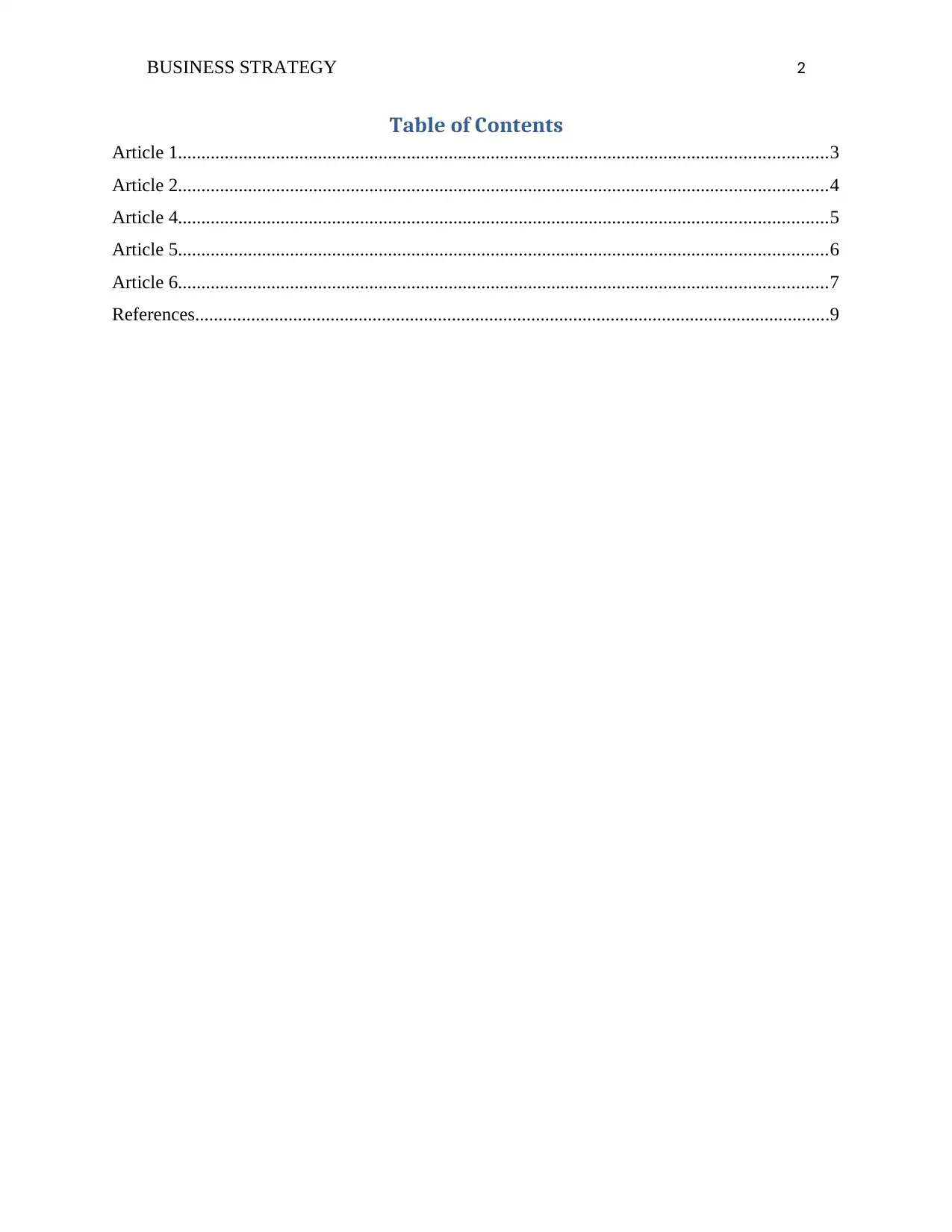
BUSINESS STRATEGY 2
Table of Contents
Article 1...........................................................................................................................................3
Article 2...........................................................................................................................................4
Article 4...........................................................................................................................................5
Article 5...........................................................................................................................................6
Article 6...........................................................................................................................................7
References........................................................................................................................................9
Table of Contents
Article 1...........................................................................................................................................3
Article 2...........................................................................................................................................4
Article 4...........................................................................................................................................5
Article 5...........................................................................................................................................6
Article 6...........................................................................................................................................7
References........................................................................................................................................9
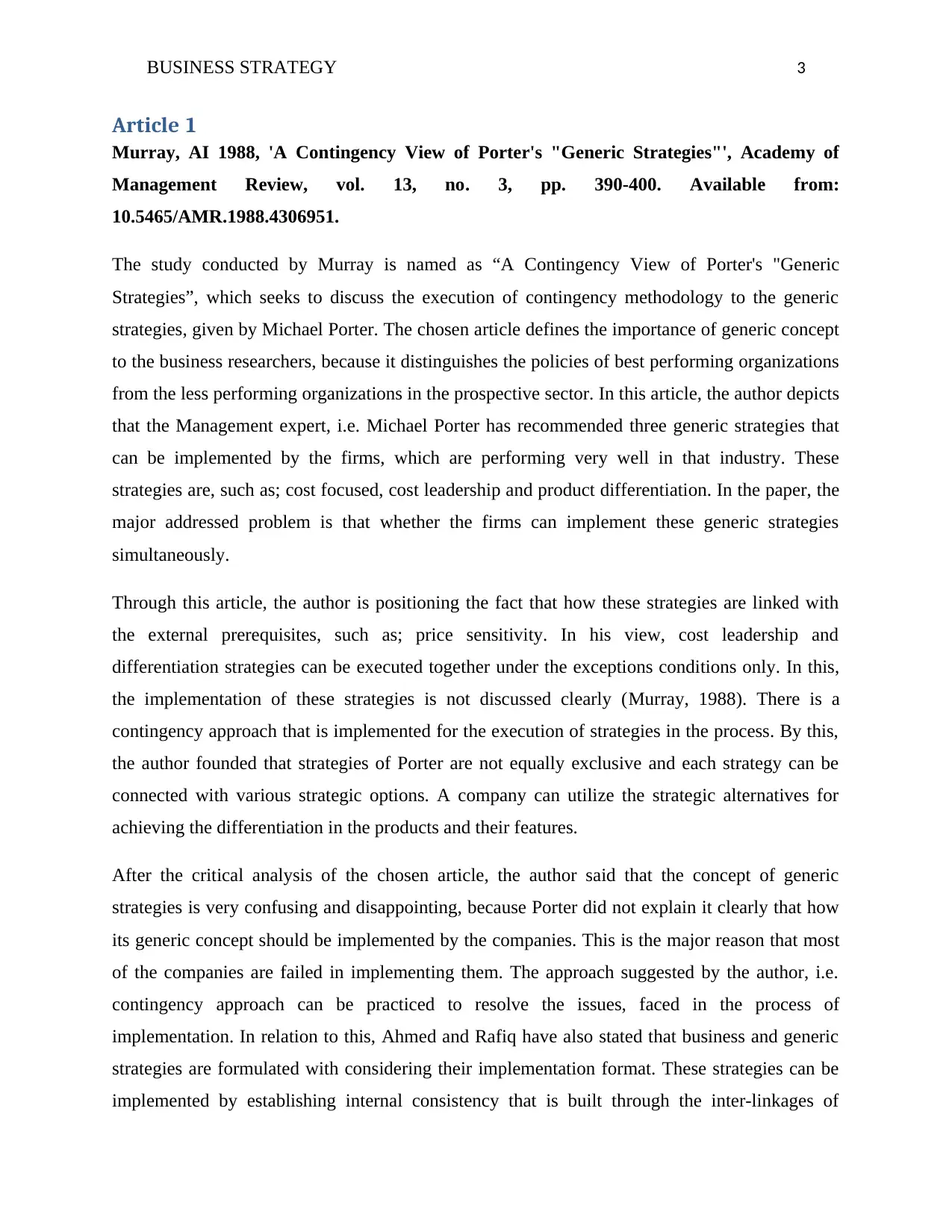
BUSINESS STRATEGY 3
Article 1
Murray, AI 1988, 'A Contingency View of Porter's "Generic Strategies"', Academy of
Management Review, vol. 13, no. 3, pp. 390-400. Available from:
10.5465/AMR.1988.4306951.
The study conducted by Murray is named as “A Contingency View of Porter's "Generic
Strategies”, which seeks to discuss the execution of contingency methodology to the generic
strategies, given by Michael Porter. The chosen article defines the importance of generic concept
to the business researchers, because it distinguishes the policies of best performing organizations
from the less performing organizations in the prospective sector. In this article, the author depicts
that the Management expert, i.e. Michael Porter has recommended three generic strategies that
can be implemented by the firms, which are performing very well in that industry. These
strategies are, such as; cost focused, cost leadership and product differentiation. In the paper, the
major addressed problem is that whether the firms can implement these generic strategies
simultaneously.
Through this article, the author is positioning the fact that how these strategies are linked with
the external prerequisites, such as; price sensitivity. In his view, cost leadership and
differentiation strategies can be executed together under the exceptions conditions only. In this,
the implementation of these strategies is not discussed clearly (Murray, 1988). There is a
contingency approach that is implemented for the execution of strategies in the process. By this,
the author founded that strategies of Porter are not equally exclusive and each strategy can be
connected with various strategic options. A company can utilize the strategic alternatives for
achieving the differentiation in the products and their features.
After the critical analysis of the chosen article, the author said that the concept of generic
strategies is very confusing and disappointing, because Porter did not explain it clearly that how
its generic concept should be implemented by the companies. This is the major reason that most
of the companies are failed in implementing them. The approach suggested by the author, i.e.
contingency approach can be practiced to resolve the issues, faced in the process of
implementation. In relation to this, Ahmed and Rafiq have also stated that business and generic
strategies are formulated with considering their implementation format. These strategies can be
implemented by establishing internal consistency that is built through the inter-linkages of
Article 1
Murray, AI 1988, 'A Contingency View of Porter's "Generic Strategies"', Academy of
Management Review, vol. 13, no. 3, pp. 390-400. Available from:
10.5465/AMR.1988.4306951.
The study conducted by Murray is named as “A Contingency View of Porter's "Generic
Strategies”, which seeks to discuss the execution of contingency methodology to the generic
strategies, given by Michael Porter. The chosen article defines the importance of generic concept
to the business researchers, because it distinguishes the policies of best performing organizations
from the less performing organizations in the prospective sector. In this article, the author depicts
that the Management expert, i.e. Michael Porter has recommended three generic strategies that
can be implemented by the firms, which are performing very well in that industry. These
strategies are, such as; cost focused, cost leadership and product differentiation. In the paper, the
major addressed problem is that whether the firms can implement these generic strategies
simultaneously.
Through this article, the author is positioning the fact that how these strategies are linked with
the external prerequisites, such as; price sensitivity. In his view, cost leadership and
differentiation strategies can be executed together under the exceptions conditions only. In this,
the implementation of these strategies is not discussed clearly (Murray, 1988). There is a
contingency approach that is implemented for the execution of strategies in the process. By this,
the author founded that strategies of Porter are not equally exclusive and each strategy can be
connected with various strategic options. A company can utilize the strategic alternatives for
achieving the differentiation in the products and their features.
After the critical analysis of the chosen article, the author said that the concept of generic
strategies is very confusing and disappointing, because Porter did not explain it clearly that how
its generic concept should be implemented by the companies. This is the major reason that most
of the companies are failed in implementing them. The approach suggested by the author, i.e.
contingency approach can be practiced to resolve the issues, faced in the process of
implementation. In relation to this, Ahmed and Rafiq have also stated that business and generic
strategies are formulated with considering their implementation format. These strategies can be
implemented by establishing internal consistency that is built through the inter-linkages of
⊘ This is a preview!⊘
Do you want full access?
Subscribe today to unlock all pages.

Trusted by 1+ million students worldwide
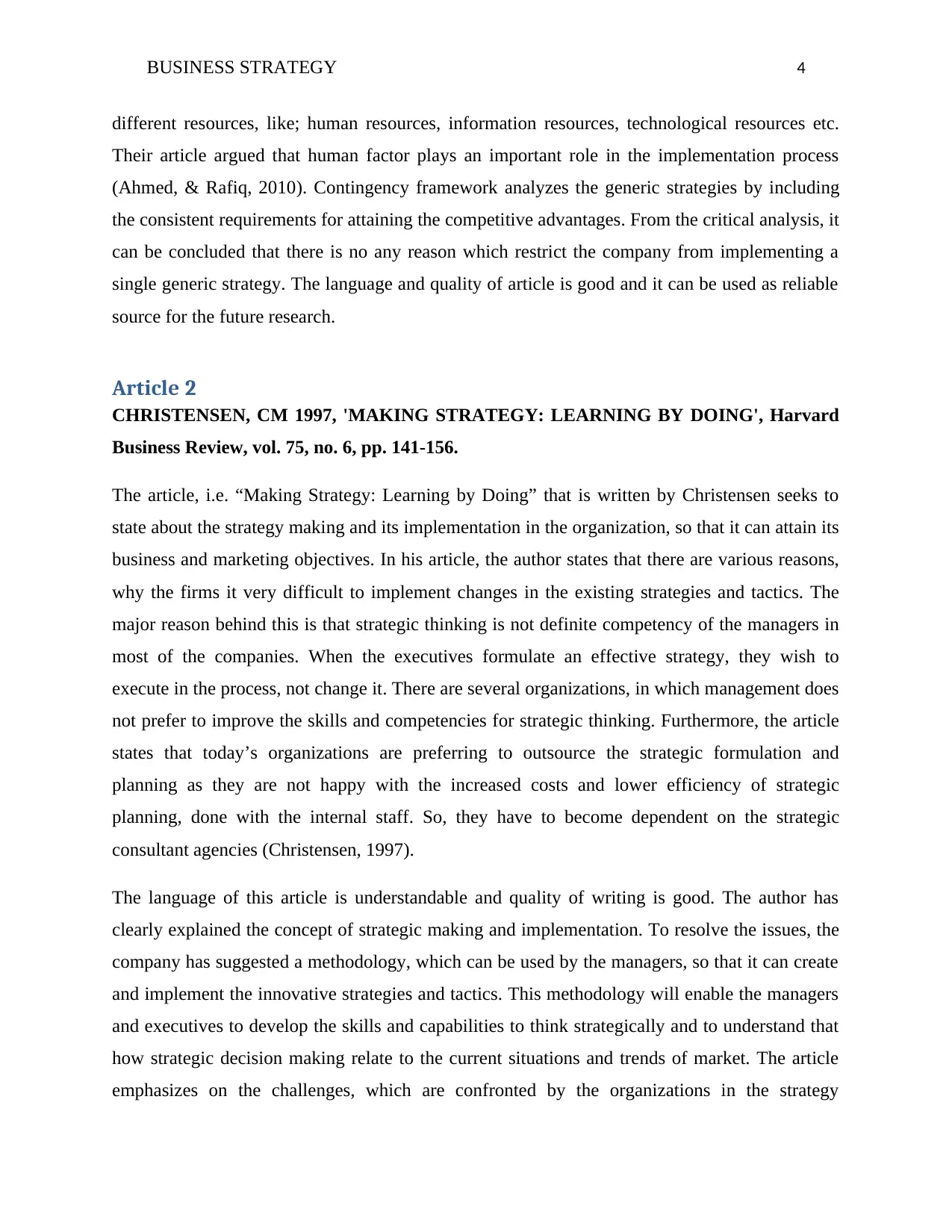
BUSINESS STRATEGY 4
different resources, like; human resources, information resources, technological resources etc.
Their article argued that human factor plays an important role in the implementation process
(Ahmed, & Rafiq, 2010). Contingency framework analyzes the generic strategies by including
the consistent requirements for attaining the competitive advantages. From the critical analysis, it
can be concluded that there is no any reason which restrict the company from implementing a
single generic strategy. The language and quality of article is good and it can be used as reliable
source for the future research.
Article 2
CHRISTENSEN, CM 1997, 'MAKING STRATEGY: LEARNING BY DOING', Harvard
Business Review, vol. 75, no. 6, pp. 141-156.
The article, i.e. “Making Strategy: Learning by Doing” that is written by Christensen seeks to
state about the strategy making and its implementation in the organization, so that it can attain its
business and marketing objectives. In his article, the author states that there are various reasons,
why the firms it very difficult to implement changes in the existing strategies and tactics. The
major reason behind this is that strategic thinking is not definite competency of the managers in
most of the companies. When the executives formulate an effective strategy, they wish to
execute in the process, not change it. There are several organizations, in which management does
not prefer to improve the skills and competencies for strategic thinking. Furthermore, the article
states that today’s organizations are preferring to outsource the strategic formulation and
planning as they are not happy with the increased costs and lower efficiency of strategic
planning, done with the internal staff. So, they have to become dependent on the strategic
consultant agencies (Christensen, 1997).
The language of this article is understandable and quality of writing is good. The author has
clearly explained the concept of strategic making and implementation. To resolve the issues, the
company has suggested a methodology, which can be used by the managers, so that it can create
and implement the innovative strategies and tactics. This methodology will enable the managers
and executives to develop the skills and capabilities to think strategically and to understand that
how strategic decision making relate to the current situations and trends of market. The article
emphasizes on the challenges, which are confronted by the organizations in the strategy
different resources, like; human resources, information resources, technological resources etc.
Their article argued that human factor plays an important role in the implementation process
(Ahmed, & Rafiq, 2010). Contingency framework analyzes the generic strategies by including
the consistent requirements for attaining the competitive advantages. From the critical analysis, it
can be concluded that there is no any reason which restrict the company from implementing a
single generic strategy. The language and quality of article is good and it can be used as reliable
source for the future research.
Article 2
CHRISTENSEN, CM 1997, 'MAKING STRATEGY: LEARNING BY DOING', Harvard
Business Review, vol. 75, no. 6, pp. 141-156.
The article, i.e. “Making Strategy: Learning by Doing” that is written by Christensen seeks to
state about the strategy making and its implementation in the organization, so that it can attain its
business and marketing objectives. In his article, the author states that there are various reasons,
why the firms it very difficult to implement changes in the existing strategies and tactics. The
major reason behind this is that strategic thinking is not definite competency of the managers in
most of the companies. When the executives formulate an effective strategy, they wish to
execute in the process, not change it. There are several organizations, in which management does
not prefer to improve the skills and competencies for strategic thinking. Furthermore, the article
states that today’s organizations are preferring to outsource the strategic formulation and
planning as they are not happy with the increased costs and lower efficiency of strategic
planning, done with the internal staff. So, they have to become dependent on the strategic
consultant agencies (Christensen, 1997).
The language of this article is understandable and quality of writing is good. The author has
clearly explained the concept of strategic making and implementation. To resolve the issues, the
company has suggested a methodology, which can be used by the managers, so that it can create
and implement the innovative strategies and tactics. This methodology will enable the managers
and executives to develop the skills and capabilities to think strategically and to understand that
how strategic decision making relate to the current situations and trends of market. The article
emphasizes on the challenges, which are confronted by the organizations in the strategy
Paraphrase This Document
Need a fresh take? Get an instant paraphrase of this document with our AI Paraphraser
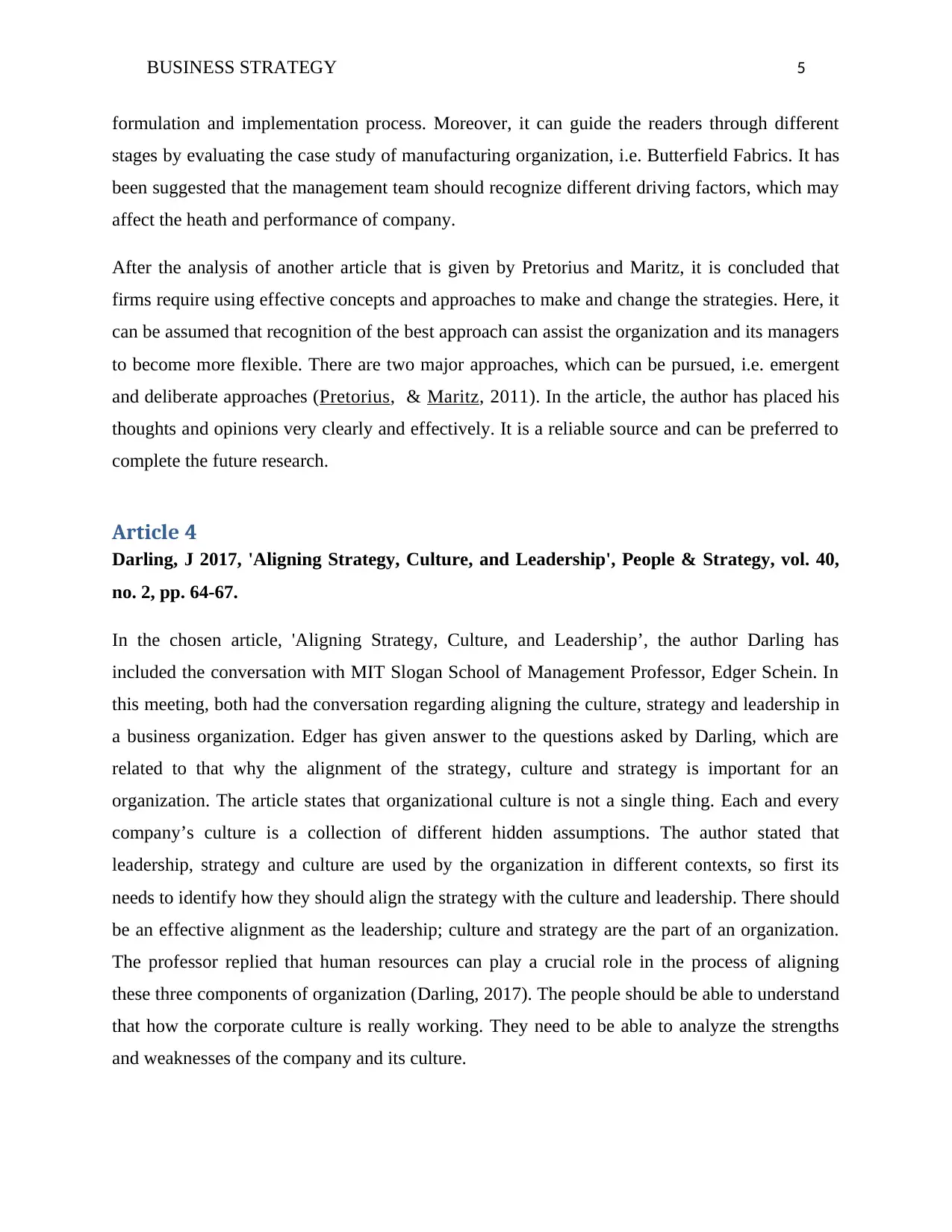
BUSINESS STRATEGY 5
formulation and implementation process. Moreover, it can guide the readers through different
stages by evaluating the case study of manufacturing organization, i.e. Butterfield Fabrics. It has
been suggested that the management team should recognize different driving factors, which may
affect the heath and performance of company.
After the analysis of another article that is given by Pretorius and Maritz, it is concluded that
firms require using effective concepts and approaches to make and change the strategies. Here, it
can be assumed that recognition of the best approach can assist the organization and its managers
to become more flexible. There are two major approaches, which can be pursued, i.e. emergent
and deliberate approaches (Pretorius, & Maritz, 2011). In the article, the author has placed his
thoughts and opinions very clearly and effectively. It is a reliable source and can be preferred to
complete the future research.
Article 4
Darling, J 2017, 'Aligning Strategy, Culture, and Leadership', People & Strategy, vol. 40,
no. 2, pp. 64-67.
In the chosen article, 'Aligning Strategy, Culture, and Leadership’, the author Darling has
included the conversation with MIT Slogan School of Management Professor, Edger Schein. In
this meeting, both had the conversation regarding aligning the culture, strategy and leadership in
a business organization. Edger has given answer to the questions asked by Darling, which are
related to that why the alignment of the strategy, culture and strategy is important for an
organization. The article states that organizational culture is not a single thing. Each and every
company’s culture is a collection of different hidden assumptions. The author stated that
leadership, strategy and culture are used by the organization in different contexts, so first its
needs to identify how they should align the strategy with the culture and leadership. There should
be an effective alignment as the leadership; culture and strategy are the part of an organization.
The professor replied that human resources can play a crucial role in the process of aligning
these three components of organization (Darling, 2017). The people should be able to understand
that how the corporate culture is really working. They need to be able to analyze the strengths
and weaknesses of the company and its culture.
formulation and implementation process. Moreover, it can guide the readers through different
stages by evaluating the case study of manufacturing organization, i.e. Butterfield Fabrics. It has
been suggested that the management team should recognize different driving factors, which may
affect the heath and performance of company.
After the analysis of another article that is given by Pretorius and Maritz, it is concluded that
firms require using effective concepts and approaches to make and change the strategies. Here, it
can be assumed that recognition of the best approach can assist the organization and its managers
to become more flexible. There are two major approaches, which can be pursued, i.e. emergent
and deliberate approaches (Pretorius, & Maritz, 2011). In the article, the author has placed his
thoughts and opinions very clearly and effectively. It is a reliable source and can be preferred to
complete the future research.
Article 4
Darling, J 2017, 'Aligning Strategy, Culture, and Leadership', People & Strategy, vol. 40,
no. 2, pp. 64-67.
In the chosen article, 'Aligning Strategy, Culture, and Leadership’, the author Darling has
included the conversation with MIT Slogan School of Management Professor, Edger Schein. In
this meeting, both had the conversation regarding aligning the culture, strategy and leadership in
a business organization. Edger has given answer to the questions asked by Darling, which are
related to that why the alignment of the strategy, culture and strategy is important for an
organization. The article states that organizational culture is not a single thing. Each and every
company’s culture is a collection of different hidden assumptions. The author stated that
leadership, strategy and culture are used by the organization in different contexts, so first its
needs to identify how they should align the strategy with the culture and leadership. There should
be an effective alignment as the leadership; culture and strategy are the part of an organization.
The professor replied that human resources can play a crucial role in the process of aligning
these three components of organization (Darling, 2017). The people should be able to understand
that how the corporate culture is really working. They need to be able to analyze the strengths
and weaknesses of the company and its culture.
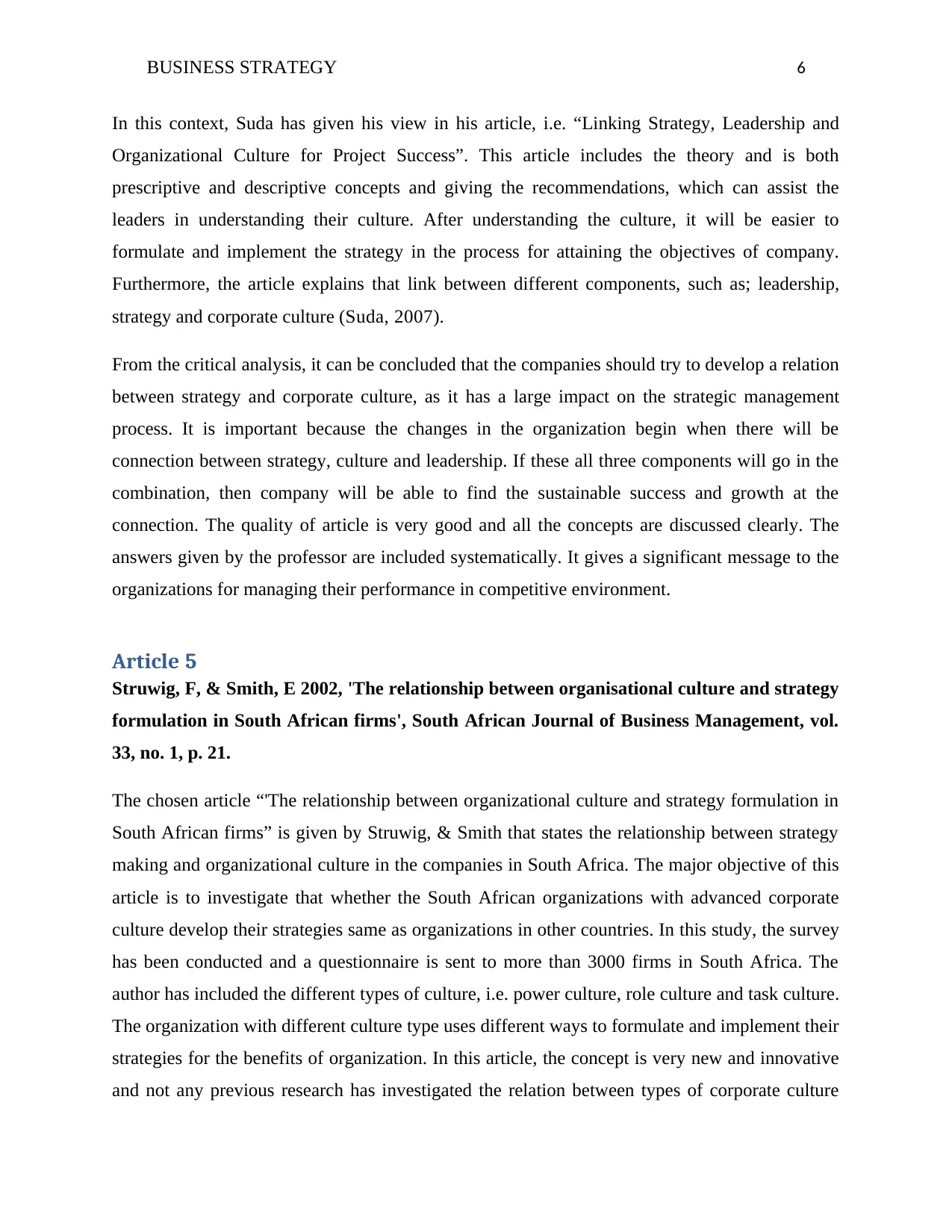
BUSINESS STRATEGY 6
In this context, Suda has given his view in his article, i.e. “Linking Strategy, Leadership and
Organizational Culture for Project Success”. This article includes the theory and is both
prescriptive and descriptive concepts and giving the recommendations, which can assist the
leaders in understanding their culture. After understanding the culture, it will be easier to
formulate and implement the strategy in the process for attaining the objectives of company.
Furthermore, the article explains that link between different components, such as; leadership,
strategy and corporate culture (Suda, 2007).
From the critical analysis, it can be concluded that the companies should try to develop a relation
between strategy and corporate culture, as it has a large impact on the strategic management
process. It is important because the changes in the organization begin when there will be
connection between strategy, culture and leadership. If these all three components will go in the
combination, then company will be able to find the sustainable success and growth at the
connection. The quality of article is very good and all the concepts are discussed clearly. The
answers given by the professor are included systematically. It gives a significant message to the
organizations for managing their performance in competitive environment.
Article 5
Struwig, F, & Smith, E 2002, 'The relationship between organisational culture and strategy
formulation in South African firms', South African Journal of Business Management, vol.
33, no. 1, p. 21.
The chosen article “'The relationship between organizational culture and strategy formulation in
South African firms” is given by Struwig, & Smith that states the relationship between strategy
making and organizational culture in the companies in South Africa. The major objective of this
article is to investigate that whether the South African organizations with advanced corporate
culture develop their strategies same as organizations in other countries. In this study, the survey
has been conducted and a questionnaire is sent to more than 3000 firms in South Africa. The
author has included the different types of culture, i.e. power culture, role culture and task culture.
The organization with different culture type uses different ways to formulate and implement their
strategies for the benefits of organization. In this article, the concept is very new and innovative
and not any previous research has investigated the relation between types of corporate culture
In this context, Suda has given his view in his article, i.e. “Linking Strategy, Leadership and
Organizational Culture for Project Success”. This article includes the theory and is both
prescriptive and descriptive concepts and giving the recommendations, which can assist the
leaders in understanding their culture. After understanding the culture, it will be easier to
formulate and implement the strategy in the process for attaining the objectives of company.
Furthermore, the article explains that link between different components, such as; leadership,
strategy and corporate culture (Suda, 2007).
From the critical analysis, it can be concluded that the companies should try to develop a relation
between strategy and corporate culture, as it has a large impact on the strategic management
process. It is important because the changes in the organization begin when there will be
connection between strategy, culture and leadership. If these all three components will go in the
combination, then company will be able to find the sustainable success and growth at the
connection. The quality of article is very good and all the concepts are discussed clearly. The
answers given by the professor are included systematically. It gives a significant message to the
organizations for managing their performance in competitive environment.
Article 5
Struwig, F, & Smith, E 2002, 'The relationship between organisational culture and strategy
formulation in South African firms', South African Journal of Business Management, vol.
33, no. 1, p. 21.
The chosen article “'The relationship between organizational culture and strategy formulation in
South African firms” is given by Struwig, & Smith that states the relationship between strategy
making and organizational culture in the companies in South Africa. The major objective of this
article is to investigate that whether the South African organizations with advanced corporate
culture develop their strategies same as organizations in other countries. In this study, the survey
has been conducted and a questionnaire is sent to more than 3000 firms in South Africa. The
author has included the different types of culture, i.e. power culture, role culture and task culture.
The organization with different culture type uses different ways to formulate and implement their
strategies for the benefits of organization. In this article, the concept is very new and innovative
and not any previous research has investigated the relation between types of corporate culture
⊘ This is a preview!⊘
Do you want full access?
Subscribe today to unlock all pages.

Trusted by 1+ million students worldwide
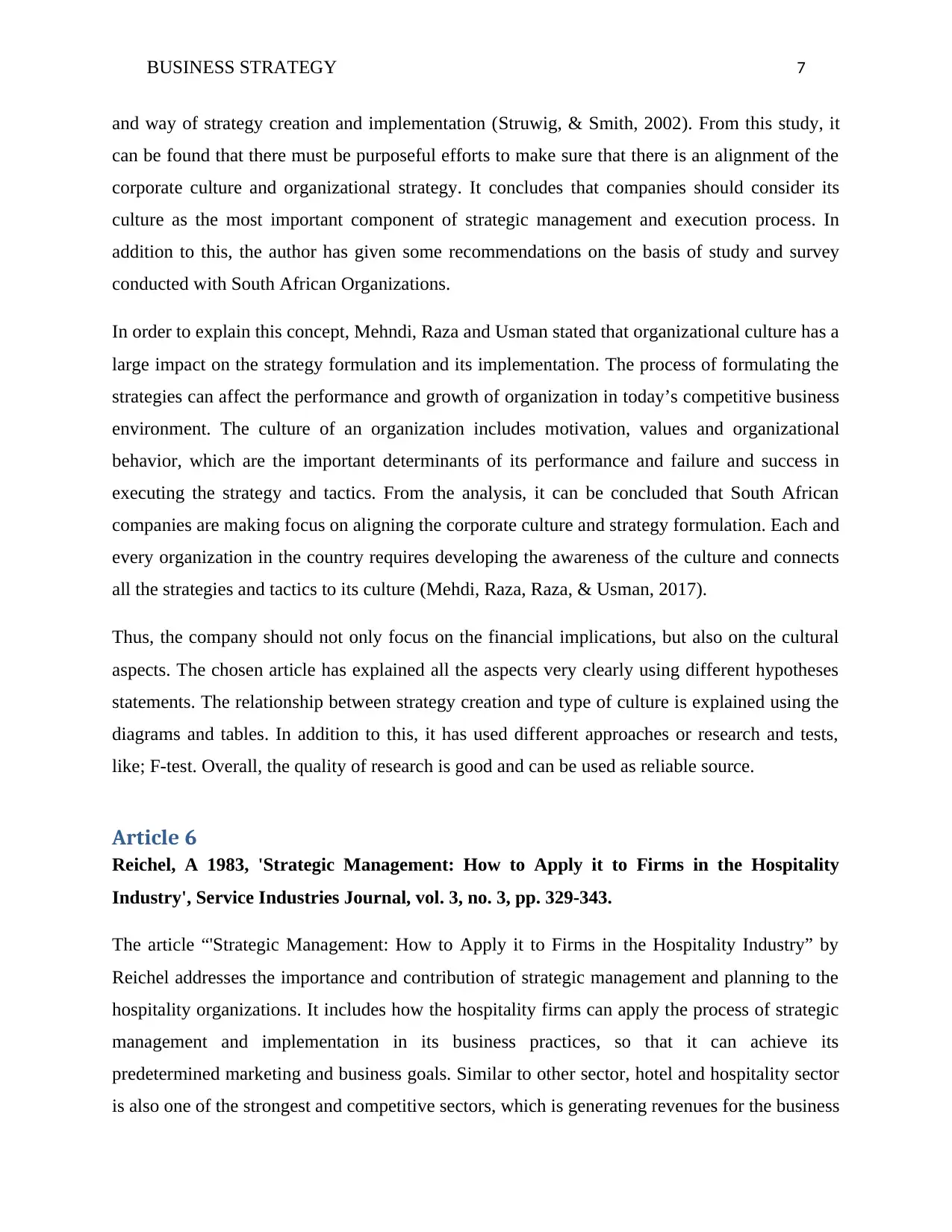
BUSINESS STRATEGY 7
and way of strategy creation and implementation (Struwig, & Smith, 2002). From this study, it
can be found that there must be purposeful efforts to make sure that there is an alignment of the
corporate culture and organizational strategy. It concludes that companies should consider its
culture as the most important component of strategic management and execution process. In
addition to this, the author has given some recommendations on the basis of study and survey
conducted with South African Organizations.
In order to explain this concept, Mehndi, Raza and Usman stated that organizational culture has a
large impact on the strategy formulation and its implementation. The process of formulating the
strategies can affect the performance and growth of organization in today’s competitive business
environment. The culture of an organization includes motivation, values and organizational
behavior, which are the important determinants of its performance and failure and success in
executing the strategy and tactics. From the analysis, it can be concluded that South African
companies are making focus on aligning the corporate culture and strategy formulation. Each and
every organization in the country requires developing the awareness of the culture and connects
all the strategies and tactics to its culture (Mehdi, Raza, Raza, & Usman, 2017).
Thus, the company should not only focus on the financial implications, but also on the cultural
aspects. The chosen article has explained all the aspects very clearly using different hypotheses
statements. The relationship between strategy creation and type of culture is explained using the
diagrams and tables. In addition to this, it has used different approaches or research and tests,
like; F-test. Overall, the quality of research is good and can be used as reliable source.
Article 6
Reichel, A 1983, 'Strategic Management: How to Apply it to Firms in the Hospitality
Industry', Service Industries Journal, vol. 3, no. 3, pp. 329-343.
The article “'Strategic Management: How to Apply it to Firms in the Hospitality Industry” by
Reichel addresses the importance and contribution of strategic management and planning to the
hospitality organizations. It includes how the hospitality firms can apply the process of strategic
management and implementation in its business practices, so that it can achieve its
predetermined marketing and business goals. Similar to other sector, hotel and hospitality sector
is also one of the strongest and competitive sectors, which is generating revenues for the business
and way of strategy creation and implementation (Struwig, & Smith, 2002). From this study, it
can be found that there must be purposeful efforts to make sure that there is an alignment of the
corporate culture and organizational strategy. It concludes that companies should consider its
culture as the most important component of strategic management and execution process. In
addition to this, the author has given some recommendations on the basis of study and survey
conducted with South African Organizations.
In order to explain this concept, Mehndi, Raza and Usman stated that organizational culture has a
large impact on the strategy formulation and its implementation. The process of formulating the
strategies can affect the performance and growth of organization in today’s competitive business
environment. The culture of an organization includes motivation, values and organizational
behavior, which are the important determinants of its performance and failure and success in
executing the strategy and tactics. From the analysis, it can be concluded that South African
companies are making focus on aligning the corporate culture and strategy formulation. Each and
every organization in the country requires developing the awareness of the culture and connects
all the strategies and tactics to its culture (Mehdi, Raza, Raza, & Usman, 2017).
Thus, the company should not only focus on the financial implications, but also on the cultural
aspects. The chosen article has explained all the aspects very clearly using different hypotheses
statements. The relationship between strategy creation and type of culture is explained using the
diagrams and tables. In addition to this, it has used different approaches or research and tests,
like; F-test. Overall, the quality of research is good and can be used as reliable source.
Article 6
Reichel, A 1983, 'Strategic Management: How to Apply it to Firms in the Hospitality
Industry', Service Industries Journal, vol. 3, no. 3, pp. 329-343.
The article “'Strategic Management: How to Apply it to Firms in the Hospitality Industry” by
Reichel addresses the importance and contribution of strategic management and planning to the
hospitality organizations. It includes how the hospitality firms can apply the process of strategic
management and implementation in its business practices, so that it can achieve its
predetermined marketing and business goals. Similar to other sector, hotel and hospitality sector
is also one of the strongest and competitive sectors, which is generating revenues for the business
Paraphrase This Document
Need a fresh take? Get an instant paraphrase of this document with our AI Paraphraser
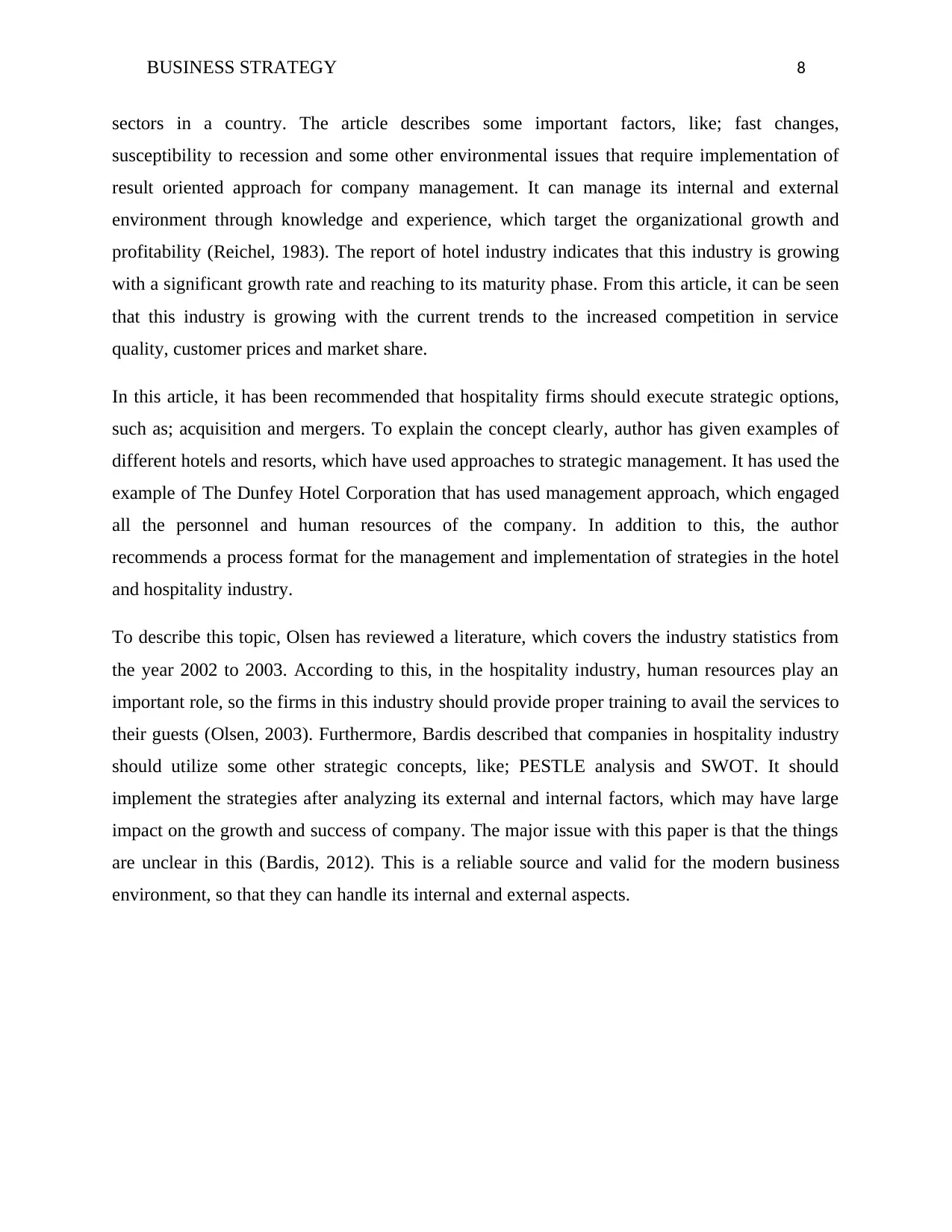
BUSINESS STRATEGY 8
sectors in a country. The article describes some important factors, like; fast changes,
susceptibility to recession and some other environmental issues that require implementation of
result oriented approach for company management. It can manage its internal and external
environment through knowledge and experience, which target the organizational growth and
profitability (Reichel, 1983). The report of hotel industry indicates that this industry is growing
with a significant growth rate and reaching to its maturity phase. From this article, it can be seen
that this industry is growing with the current trends to the increased competition in service
quality, customer prices and market share.
In this article, it has been recommended that hospitality firms should execute strategic options,
such as; acquisition and mergers. To explain the concept clearly, author has given examples of
different hotels and resorts, which have used approaches to strategic management. It has used the
example of The Dunfey Hotel Corporation that has used management approach, which engaged
all the personnel and human resources of the company. In addition to this, the author
recommends a process format for the management and implementation of strategies in the hotel
and hospitality industry.
To describe this topic, Olsen has reviewed a literature, which covers the industry statistics from
the year 2002 to 2003. According to this, in the hospitality industry, human resources play an
important role, so the firms in this industry should provide proper training to avail the services to
their guests (Olsen, 2003). Furthermore, Bardis described that companies in hospitality industry
should utilize some other strategic concepts, like; PESTLE analysis and SWOT. It should
implement the strategies after analyzing its external and internal factors, which may have large
impact on the growth and success of company. The major issue with this paper is that the things
are unclear in this (Bardis, 2012). This is a reliable source and valid for the modern business
environment, so that they can handle its internal and external aspects.
sectors in a country. The article describes some important factors, like; fast changes,
susceptibility to recession and some other environmental issues that require implementation of
result oriented approach for company management. It can manage its internal and external
environment through knowledge and experience, which target the organizational growth and
profitability (Reichel, 1983). The report of hotel industry indicates that this industry is growing
with a significant growth rate and reaching to its maturity phase. From this article, it can be seen
that this industry is growing with the current trends to the increased competition in service
quality, customer prices and market share.
In this article, it has been recommended that hospitality firms should execute strategic options,
such as; acquisition and mergers. To explain the concept clearly, author has given examples of
different hotels and resorts, which have used approaches to strategic management. It has used the
example of The Dunfey Hotel Corporation that has used management approach, which engaged
all the personnel and human resources of the company. In addition to this, the author
recommends a process format for the management and implementation of strategies in the hotel
and hospitality industry.
To describe this topic, Olsen has reviewed a literature, which covers the industry statistics from
the year 2002 to 2003. According to this, in the hospitality industry, human resources play an
important role, so the firms in this industry should provide proper training to avail the services to
their guests (Olsen, 2003). Furthermore, Bardis described that companies in hospitality industry
should utilize some other strategic concepts, like; PESTLE analysis and SWOT. It should
implement the strategies after analyzing its external and internal factors, which may have large
impact on the growth and success of company. The major issue with this paper is that the things
are unclear in this (Bardis, 2012). This is a reliable source and valid for the modern business
environment, so that they can handle its internal and external aspects.
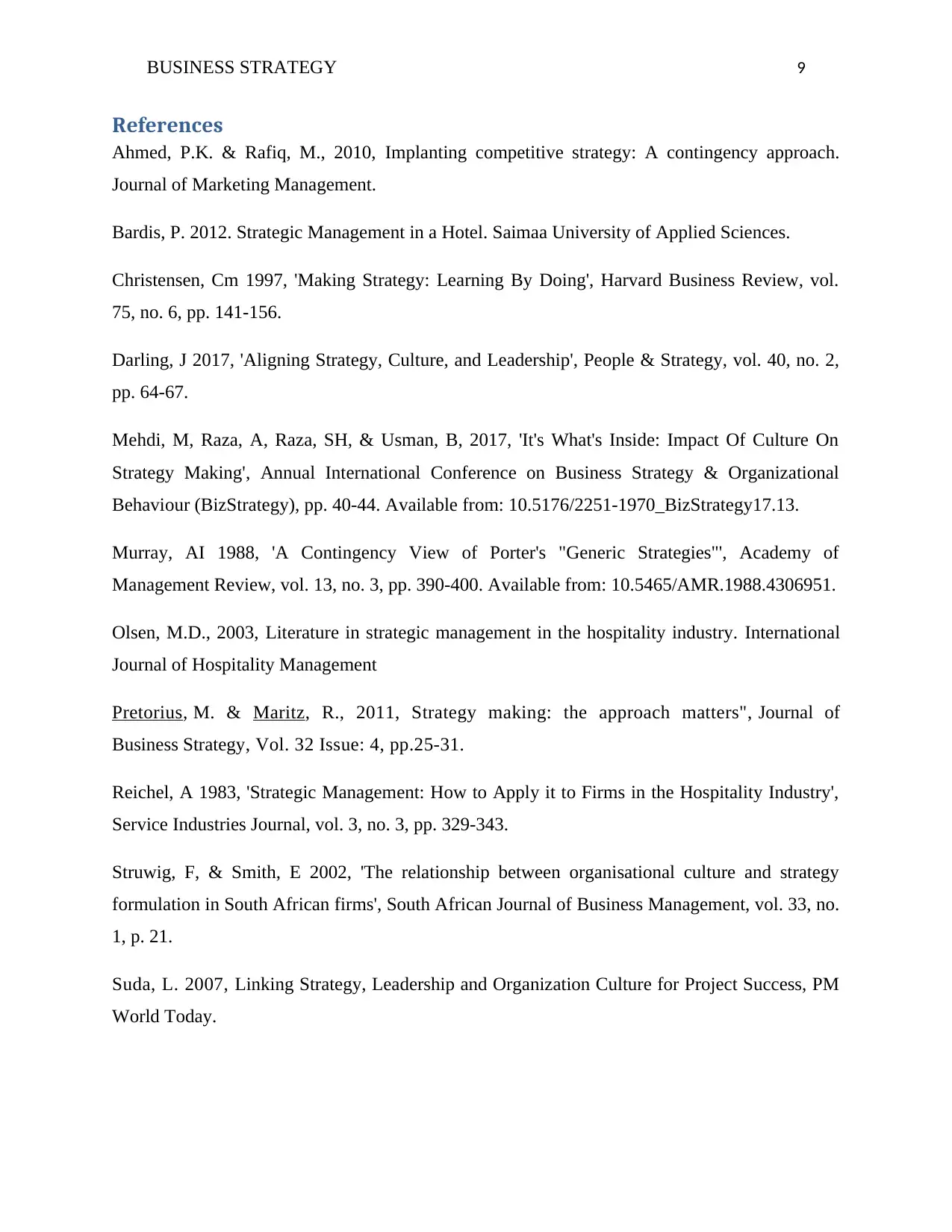
BUSINESS STRATEGY 9
References
Ahmed, P.K. & Rafiq, M., 2010, Implanting competitive strategy: A contingency approach.
Journal of Marketing Management.
Bardis, P. 2012. Strategic Management in a Hotel. Saimaa University of Applied Sciences.
Christensen, Cm 1997, 'Making Strategy: Learning By Doing', Harvard Business Review, vol.
75, no. 6, pp. 141-156.
Darling, J 2017, 'Aligning Strategy, Culture, and Leadership', People & Strategy, vol. 40, no. 2,
pp. 64-67.
Mehdi, M, Raza, A, Raza, SH, & Usman, B, 2017, 'It's What's Inside: Impact Of Culture On
Strategy Making', Annual International Conference on Business Strategy & Organizational
Behaviour (BizStrategy), pp. 40-44. Available from: 10.5176/2251-1970_BizStrategy17.13.
Murray, AI 1988, 'A Contingency View of Porter's "Generic Strategies"', Academy of
Management Review, vol. 13, no. 3, pp. 390-400. Available from: 10.5465/AMR.1988.4306951.
Olsen, M.D., 2003, Literature in strategic management in the hospitality industry. International
Journal of Hospitality Management
Pretorius, M. & Maritz, R., 2011, Strategy making: the approach matters", Journal of
Business Strategy, Vol. 32 Issue: 4, pp.25-31.
Reichel, A 1983, 'Strategic Management: How to Apply it to Firms in the Hospitality Industry',
Service Industries Journal, vol. 3, no. 3, pp. 329-343.
Struwig, F, & Smith, E 2002, 'The relationship between organisational culture and strategy
formulation in South African firms', South African Journal of Business Management, vol. 33, no.
1, p. 21.
Suda, L. 2007, Linking Strategy, Leadership and Organization Culture for Project Success, PM
World Today.
References
Ahmed, P.K. & Rafiq, M., 2010, Implanting competitive strategy: A contingency approach.
Journal of Marketing Management.
Bardis, P. 2012. Strategic Management in a Hotel. Saimaa University of Applied Sciences.
Christensen, Cm 1997, 'Making Strategy: Learning By Doing', Harvard Business Review, vol.
75, no. 6, pp. 141-156.
Darling, J 2017, 'Aligning Strategy, Culture, and Leadership', People & Strategy, vol. 40, no. 2,
pp. 64-67.
Mehdi, M, Raza, A, Raza, SH, & Usman, B, 2017, 'It's What's Inside: Impact Of Culture On
Strategy Making', Annual International Conference on Business Strategy & Organizational
Behaviour (BizStrategy), pp. 40-44. Available from: 10.5176/2251-1970_BizStrategy17.13.
Murray, AI 1988, 'A Contingency View of Porter's "Generic Strategies"', Academy of
Management Review, vol. 13, no. 3, pp. 390-400. Available from: 10.5465/AMR.1988.4306951.
Olsen, M.D., 2003, Literature in strategic management in the hospitality industry. International
Journal of Hospitality Management
Pretorius, M. & Maritz, R., 2011, Strategy making: the approach matters", Journal of
Business Strategy, Vol. 32 Issue: 4, pp.25-31.
Reichel, A 1983, 'Strategic Management: How to Apply it to Firms in the Hospitality Industry',
Service Industries Journal, vol. 3, no. 3, pp. 329-343.
Struwig, F, & Smith, E 2002, 'The relationship between organisational culture and strategy
formulation in South African firms', South African Journal of Business Management, vol. 33, no.
1, p. 21.
Suda, L. 2007, Linking Strategy, Leadership and Organization Culture for Project Success, PM
World Today.
⊘ This is a preview!⊘
Do you want full access?
Subscribe today to unlock all pages.

Trusted by 1+ million students worldwide
1 out of 9
Related Documents
Your All-in-One AI-Powered Toolkit for Academic Success.
+13062052269
info@desklib.com
Available 24*7 on WhatsApp / Email
![[object Object]](/_next/static/media/star-bottom.7253800d.svg)
Unlock your academic potential
Copyright © 2020–2025 A2Z Services. All Rights Reserved. Developed and managed by ZUCOL.





